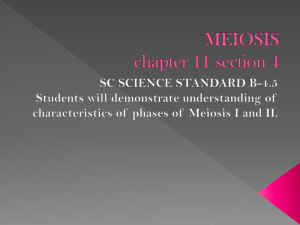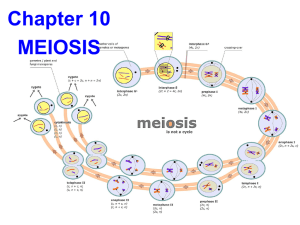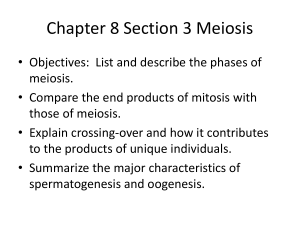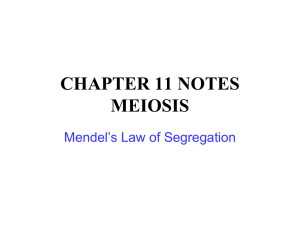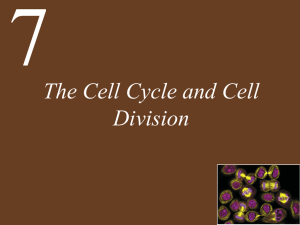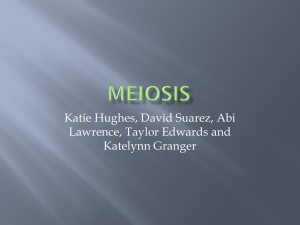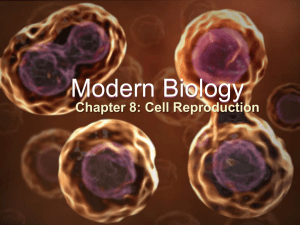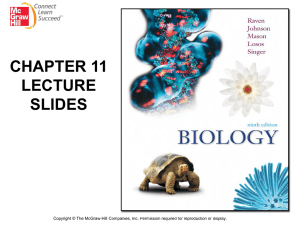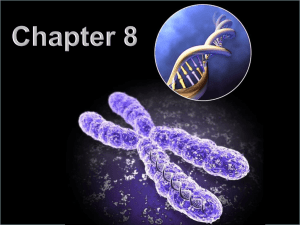metaphase ii
advertisement
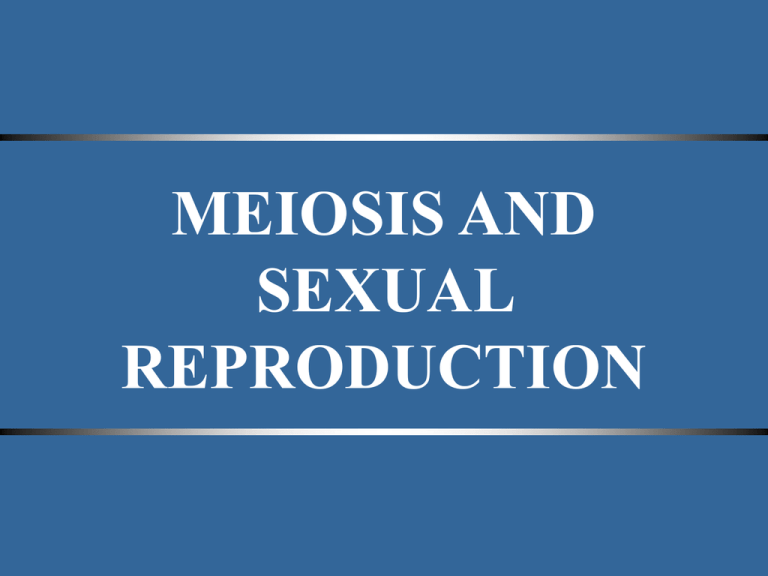
MEIOSIS AND SEXUAL REPRODUCTION CHAPTER OUTLINE I. OVERVIEW II. HAPLOID AND DIPLOID III. MEIOSIS, LIFE CYCLE AND DIPLOIDY IV. THE PROCESS OF MEIOSIS V. POST MEIOTIC EVENTS A. OVERVIEW B. MEGASPOROGENESIS C. MICROSPOROGENESIS D. OOGENESIS E. SPERMATOGENESIS VI. ASEXUAL REPRODUCTION Haploid and Diploid Generations Most eukaryotic organisms have an alternation of haploid and diploid generations. In animals, the haploid generation is onecelled. In plants, it usually is many celled. Example, fungi and algae such as Chlamydomonas Example: Humans Plants MITOSIS AND MEIOSIS MITOSIS •Somatic Cells •Daughter cells identical to parent cells •No Genetic recombination 2n=2 MEIOSIS •Gametes or spores •Daughter cells have half of the chromosomes of the parent •Genetic recombination • Reassortment 2n=2 2n=2 n=1 MITOSIS MEIOSIS Chromosome number is reduced The Process of Meiosis Interphase I Chromosomes duplicate to form two chromatids during S phase A a AA aa Each chromosome is composed of two chromatids PROPHASE I 1. Synapsis of homologous chromosomes a. the synaptonemal complex b. gene for gene pairing 2. Crossing over (Recombination) 3. Chromosome condensation 4. Spindle forms 5. Nuclear membrane disappears The stages of chromosome condensation in prophase Leptotene Zygotene Pachytene Diplotene Diakinesis Prophase I Homologous chromosomes synapsed Blue = 2 chromatids, yellow = 2 chromatids Crossing over occurs RECOMBINATION Chromosomes showing the characteristic X-shaped chiasma that result from crossing over between homologous chromosomes Synaptonemal complexes in Hyalophora cecropia (silk moth). The normal male chromosome number is 62 giving 31 pairs. In the individual shown here, one chromosome is present in three copies (center). The dark spot is the nucleolus (site of ribosomal RNA synthesis) Synaptonemal complex (dark lines) Loops of chromosomal material Nucleolus Unpaired chromosome in Lilium tyrinum - note central core and lateral loops of chromosome material Fig 9-8 a,b Synaptonemal complex in Lilium tyrinum. Note synaptonemal complex and chromosome loops on the sides Recombination is a source of genetic variability. Materials on a chromosome are re-arranged with respect to each other Maternal Grandparents Paternal Grandparents Mother Father You METAPHASE I AA aa Metaphase in Lilium regale METAPHASE I THE LAW OF INDEPENDENT ASSORTMENT A a B b or A b a B Segregation of homologous chromosome pair 1 is independent of segregation of homologous pair 2 This independent assortment results in mixing of chromosome sets from the mother (black) and father (red) = reassortment Figure 9-10 MEIOSIS PRODUCES GENETIC VARIABILITY • In prophase as a result of crossing over • In metaphase I as a result of the way chromosomes line up on the metaphase plate (reassortment) MEIOSIS UNDERGOES TWO CELL DIVISIONS AND REDUCES THE CHROMOSOME NUMBER TO THE HAPLOID OR N NUMBER METAPHASE I. Homologous chromosomes line up on the Metaphase plate Metaphase plate seen from the top Metaphase plate seen from the side ANAPHASE I Early anaphase A A a a Late anaphase ANAPHASE I - Homologous chromosomes separate (reduction division) Telophase I, Interphase I and Prophase II may or may not occur, depending on the organism Telophase I Interphase I Prophase II METAPHASE II A A aa Anaphase I METAPHASE II • Spindle reforms at right angles to the original spindles • Chromosomes (each composed of 2 sister chromatids) line up on the metaphase plate ANAPHASE II A A a a ANAPHASE II - Sister chromatids separate TELOPHASE II A A a a TELOPHASE II - New nuclear membranes form around the 4 daughter cells POST-MEIOTIC MODIFICATIONS Microspore development in higher plants (formation of the male gametophyte) Microspores are the product of meiosis before differentiation into pollen Microspores undergo 1 round of mitotic division to produce a pollen cell with two nuclei Pollen released from anthers HAPLOID OOGENESIS SPERMATOGENESIS Asexual reproduction Stolons Vegetative propagules are genetically identical to the parent END MEIOSIS

